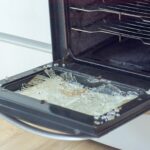Glass pots are having a rebirth in our kitchens. Glass pots were all the rage around Europe in the 1970s, and they are coming back to our kitchens for many reasons.
A lot of people love the look of glass cookware but don’t know too much about it. We’ve covered the advantages and disadvantages of glass cookware in a separate article.
Today, we’re focusing on using this cookware on a gas hob.
Can You Use Glass Cookware on a Gas Stove?
Glass pots are made from different types of glass, and the type of glass that your cookware is made from determines whether or not it can be used over a naked flame.
Most glass cookware is made from either tempered glass or borosilicate glass. Borosilicate glass is ideal for use on a gas stove. Tempered glass, on the other hand, is not suitable for using directly over a flame.
A short history on Pyrex and tempered glass

Pyrex has been a staple in our kitchens for years, and it is often the go-to for glass cookware like measuring jugs and glass casserole dishes.
For much of the history of Pyrex, the glass cookware was made from borosilicate glass, so it was perfectly suited for use on a gas hob.
However, in the 90s, Pyrex was brought by an American company that changed the way the cookware was made. Pyrex is now made using tempered glass.
Tempered glass can shatter when used on a gas hob. This is because it can expand with the heat and then rapidly cool with the air temperature.
Of course, most Pyrex products are designed never to be used on the hob, anyway. Still, the fact remains that tempered glass is not suitable for use on a gas stove.
What about borosilicate glass?

Borosilicate glass contains boron trioxide. Without getting too chemical, this basically prevents the glass from expanding too much when heated.
As the glass doesn’t expand as much when heated, rapidly cooling it doesn’t shock the glass and crack it like with tempered glass, for example. This means that borosilicate glass is ideal for use on a gas hob.
So, glass stovetop kettles, glass pots, and pans should be made from borosilicate glass.
Soda-lime glass
There is also soda-lime glass in our kitchens. This is the most manufactured glass in the world and is used for everything from windows to glass bottles and jars.
Soda-lime glass is brittle compared to borosilicate glass and tempered glass, so it isn’t suitable for any type of cooking.
When you place soda-lime glass in warm water, it is very prone to cracking, which is a very good indicator of what is likely to happen when it is heated on a stove or in an oven.
Which Glass Pots Are Best for a Gas Stove?

When choosing your glass pots, you need to avoid soda-lime and tempered glass, but how do you do this? Well, the easiest way is to buy pots that state very clearly that they can be used on the hob.
Sadly, the way that glass pots are made doesn’t allow for identifying marks to be added during the casting process, so it can be a bit of a guessing game.
In short, though, if the cookware you’re interested in says it is made from tempered glass, it will probably crack on a gas stove. The same goes for soda-lime glass.
So, just make sure the cookware states that it’s made from borosilicate glass or that it clearly shows or says it is safe for use on a gas hob in the literature.
We hope this look at glass pots and whether they can be used on a gas stove has been helpful. To find out more about glass cookware, please Explore Chef’s Pick further.
Glass cookware is making a comeback in our kitchens, and we are really pleased to see it. However, choosing the right glass cookware is a must to ensure it lasts for as long as possible.

Scott is a writer and a passionate home chef. His passion for cooking began when he was 10 years old. Scott has been writing professionally for over five years now and loves to combine his passion for cooking with his day job.



